Fog and Fatigue
The official accident report stated that the cause of the accident was "failure of the pilot to maintain altitude and proper climb during the missed approach."
The 5000-hr pilot was flying a night charter. Destination weather was forecast to be 10,000 ft. broken, with 2 mi. visibility in fog and haze. However, on arrival, he found that the weather was much worse. The Automated Weather Observation System (AWOS) reported a 300-ft. overcast ceiling and 1/2 mi. visibility. Nevertheless, he reported that he could see the runway through the fog. He requested and was cleared for a contact approach. But during his descent, fog moved over the runway, and he missed the approach. Since he still had 2.5 hrs of fuel on board, he decided to hold for a while to wait for the fog to clear.
Only a few minutes later, he changed his mind and requested clearance to his alternate, which had been reporting an 8000-ft. ceiling with 2 mi. visibility in fog and a temperature-dew point spread of one degree. By the time he arrived at the alternate, the weather there had deteriorated significantly (a pilot on the ground reported visibility near zero in fog).
His first attempt at the ILS approach missed. So did the second. During the second missed approach, he flew into the ground and died.
The pilot routinely worked for his family's business all day and then flew all night for a charter company. At the time of the accident, he had been flying for only about 6 hrs, but he had been awake for more than 21.
The real cause of this accident was fatigue.
Originally Published: ASL 2/1997
Original Article: Fog and Fatigue
Underwater Egress — Revisited
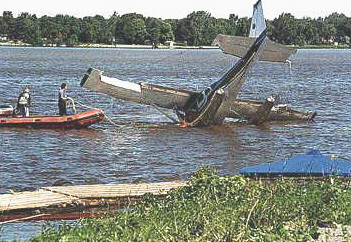
The following accident represents a nightmare for all pilots (what accident doesn’t?), but particularly for seaplane pilots. It was the subject of "Learning From Others," an excellent letter from a reader in Aviation Safety Letter 2/97, but the recent release of Transportation Safety Board (TSB) Final Report A96Q0114 gave us no alternative but to highlight this tragic accident before the summer of 1998 arrives. We will also address specific issues relating to the aft emergency exit on the Cessna 206 series floatplane and emergency egress from an inverted, water-filled aircraft. The following has been condensed from information contained in the TSB Final Report, which is available on the TSB’s Web site http://www.tsb.gc.ca/.
On July 20, 1996, the float-equipped Cessna U206F with six persons on board started its takeoff run on Rivière des Prairies, Quebec, on a water surface agitated by strong crosswinds from the right. The aircraft lifted out of the water at very low speed, travelled about 1000 ft. before taking off, and fell back on the water in a pronounced nose-up attitude. The pilot continued with the takeoff, and the aircraft lifted out of the water a second time. The left wing then struck the surface of the water, the left float dug into the water, and the aircraft capsized. The pilot told the passengers to unfasten their seatbelts as the aircraft rapidly filled with water. He then went toward the rear to try to open the two cargo doors to let the occupants out. A witness immediately proceeded to the site to assist the occupants. He opened the left front door, and the female passenger and her child evacuated the seaplane. As they had no life jackets, these two persons clung to the floats until the other rescuers arrived. The first firefighters and police officers arrived at the site about 15 min after the accident. The pilot and the other three passengers had drowned inside the aircraft.
The TSB determined that the pilot had been unable to maintain control of the aircraft, which was equipped with Robertson and Flint Aero kits, during a takeoff with 20° of flap in strong crosswind conditions. It also determined that the distribution of the passengers and the complexity of opening the leaves of the rear cargo door with the flaps extended to 20° contributed to the difficulty of the evacuation. There are several issues worth looking into here, but we will limit our discussion to two main areas: (1) the pilot’s decision-making process before and during the short flight, and (2) the aft emergency exit of the Cessna 206 and emergency egress from a water-filled, inverted aircraft.
The facts as provided in the TSB Report would lead many to question why this flight was attempted. Unfortunately, we will never know for sure what led the pilot to go ahead with it. Some would postpone a pleasure flight in a seaplane with three children on board when faced with strong crosswinds and agitated waves, but it often becomes a personal judgement call; it can be assumed that other experienced seaplane pilots might also have decided that the conditions at the time were acceptable. In any event, the pilot was obviously confident in his ability to handle the crosswind; perhaps the fact that the aircraft was equipped with a short takeoff and landing kit and auxiliary wing-tip tank kit, which increase lift and reduce the stall speed of the aircraft, reinforced his confidence.
The second question mark arises from the fact that, during the initial takeoff, the aircraft fell back on the water in a pronounced nose-up attitude, but the pilot decided to continue with the takeoff. The only answers to these questions reside in the complex world of human factors, as they apply to the pilot’s own motivations and self-imposed pressures to go ahead with the flight. As stated in the ASL 2/97 article, remember this particular occurrence the next time that you are faced with similar circumstances.
Emergency Exit
A second fatal accident in less than 12 months brought the issue of the Cessna 206 emergency exit to the forefront. On June 1, 1997, a U.S.-registered float-equipped Cessna 206 had a similar accident at Carroll Lake, Ontario, when the aircraft nosed over in the water, and two passengers were unable to evacuate the aircraft and drowned (TSB A97C0090). In this particular case, the pilot had left the wheels down when he touched down on the water.
The Cessna 206 is equipped with a double cargo door on the right rear side that doubles as an emergency exit. When the flaps are extended to 20°, the forward leaf of the cargo door can open only about 8 cm, and this makes it difficult to fully open the aft leaf of the cargo door. The emergency-exit instructions found in the owner’s manual say that, if it is necessary to use the cargo doors as an emergency exit and the wing flaps are extended, the doors are to be opened in accordance with the instructions shown on the red placard mounted on the forward cargo door. According to the TSB Final Report, the instructions found on the placard of the accident aircraft were as follows:
Emergency exit operation:
- Rotate forward cargodoor handle full forward then full aft.
- Open forward cargo door as far as possible.
- Rotate red lever in rear cargo door forward.
- Force rear cargo door full open.
In ASL 7/90, as a result of a safety information letter from the Canadian Aviation Safety Board, we showed the correct procedure for opening the doors with the flaps down. The procedure is repeated below, along with the original graphic, which clearly illustrates the difficulty:
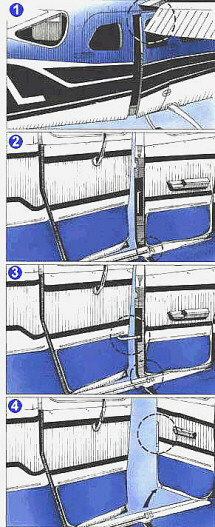
(a) unlatch the forward cargo door;
(b) open the forward cargo door as much as possible (about 3 in.) (figures 1 and 2);
(c) unlatch the rear cargo door by pulling down on the red handle (figure 2);
(d) partially open the rear door until the door latch at the base of the door is clear of the floor (figure 3);
(e) close the rear cargo door latch by placing the red handle into the well in the door jamb (the locking pins will now be extended, but clear of the fuselage); and
(f) push open the rear cargo door (figure 4).
This sequence shows that the placard leaves out some of the above steps. Now this procedure is quite demanding for most people under normal circumstances. Picture the process in the dark, in an inverted airplane, in rushing water and with two or three distressed passengers trying to escape.
The Cessna 206 emergency-exit issue has been addressed extensively in the past by, among others, the TSB in 1985 and 1989; the ASL 7/90 article referred to above; Cessna service bulletin (SB) SEB91-04, issued on March 22, 1991; and many letters exchanged among the industry, Transport Canada (TC), the TSB and the Federal Aviation Administration (FAA) since the last two fatal accidents. In addition, you — the owners, operators and associations — are well aware of the problem. Although the SB simplifies somewhat the steps required to open the double aft cargo door, the procedure does not eliminate the jamming of the forward cargo door against the flaps when they are lowered. TC clearly stated to the FAA its position that, even with the modification, when the flaps are down, the Cessna 206 emergency exit procedure remains a multistep procedure that can be difficult to execute under emergency conditions.
Following the Carroll Lake occurrence, TC reiterated its concerns to the FAA, and, in its November 1997 reply, the FAA said that new series 206H and T206H would incorporate the provisions of SEB91-04. The FAA also said that, if TC were to issue an airworthiness directive (AD) against 206 series airplanes, the FAA would examine it for possible similar action in the United States. However, owing to the proportionally wider use of floatplanes in Canada than in the United States, the FAA could not say at that time whether an AD with the same intent would be supported by the evidence available from its U.S. databases.
Meanwhile, on November 16, 1997, TC issued Service Difficulty Alert AL-97-04, which strongly recommends that owners and operators of all Cessna 206, U206 and TU206 aircraft incorporate SB SEB91-04; instruct flight crews to brief passengers and demonstrate the steps necessary to open the exit when flaps are lowered; and ensure that flight crews periodically practice the procedure for opening the emergency exit from outside the aircraft when the flaps are down. It also recommends that there be a maximum of four occupants in the aircraft when waterborne operations are being conducted.
At this time, there is no modification available that completely resolves the emergency-exit issue. Discussions are still ongoing among TC, the FAA and the industry about the possibility of AD action.
Underwater Egress
The TSB’s final report refers to a study relating to escape and survival from a ditched aircraft. It states that the rotation of the body underwater and loss of gravitational reference makes disorientation inevitable for survivors prior to their escape from an inverted aircraft. In addition, the darkness produced by water flooding into the aircraft aggravates the disorientation. Survivors who were questioned in this study reported having experienced confusion, panic and disorientation in the occurrences. The study concludes that only those who have experienced disorientation in an underwater trainer understand the problem and know how to deal with it to get out and survive.
Having personally experienced an underwater escape trainer twice, I can attest to the fact that the above statements reflect the reality of an underwater egress situation, except that, in the trainer, you expect the situation to arise (there is no surprise effect); you have a plan or escape route in your mind (or at least you think that you do...); and you are in a clean pool with safety scuba divers. Not so in the real world. Nevertheless, underwater egress training is invaluable for any pilot who flies regularly over water, regardless of the type of aircraft flown. As a matter of fact, passengers or non-pilot crews who also fly regularly over water should consider underwater escape training. Once you have had the training, you will also be in a better position to brief your passengers about what to expect... should the unexpected occur.
Finally, ASL 2/95 featured "Seaplane Accident Survival" as its lead article, and it contained excellent information on this subject. If you do not have a copy of that article, we will be pleased to send you one upon request.
Originally Published: Aviation Safety Letter 02/1998
Original Article: Underwater Egress - Revisited
by Pat Very
En Route
There are countless combinations of routes throughout the mountains and picking the right one for you, your aircraft and your load comes with practice. The best way to learn about mountain flying is to fly in the mountains. With every flight, you will become more comfortable and knowledgeable.
Always monitor 126.7 MHz en route and request station updates when within range of an FSS. The radio operators are real professionals and are the backbone of the system. Try to confine your requests to the last 50 min. of the hour; the operators will be forever grateful for the time to get the hourly observations out on the computer for the rest of us.
Generally speaking, I like to travel as high as possible, consistent with comfort, and regularly fly at 10,000 to 12,000 ft. when crossing the rocks in VFR flight. Altitude has a number of advantages. Quite often, flying at 10,000 to 12,000 ft. will put you above scattered to broken cumulus and towering cumulus and, therefore, give you a smoother ride, lessening fatigue from turbulence. Altitude also will give you better radio reception for amendments and updates, as well as a larger spectrum from which to navigate. Then, of course, there is the old engine-failure scenario! Wouldn’t it be nice to be high if that ever happened, especially in the mountains? With the advent of LORAN and GPS, it's easy to set out blindly across the rocks, oblivious to the consequences. Knowing where you are at all times and how far it is to the nearest airport, settlement or road is a must.
Approach pass summits and ridges in level flight. The clearance required will be determined by the wind direction, velocity and cloud base. Again, look for clues — ridge plumes, cumulus, bear paws, bending trees, wind on the water, and so on — and check your vertical speed indicator and altimeter. Under no circumstances should you still be climbing for this clearance altitude when arriving at the summit or ridge. If you have to turn around, make your decision early while there is still plenty of room. By the way, don't even think about penetrating cloud; it's the quickest way that I know of to become a statistic.
Watch out for the shadowed valley sides in the late afternoon: under certain conditions, they can all but disappear, leaving you with a dangerous guessing game. If you feel uncomfortable and conditions allow, climb for better reference.
On the bright side, generally speaking and owing to prominent landmarks, map reading tends to be easier in the mountains than on flat land.
For those of you with really light aircraft such as Cubs, Champs, and ultralights, a lift bonus can occasionally be reaped by flying the sunny or downwind side of the valley. Recently, while ferrying a J-3 Cub (without mixture control) through Banff, Alberta, back to Chilliwack, British Columbia, I found myself, owing to a variety of conditions, unable to climb to a safe altitude to clear the pass. After a few unsuccessful attempts, I spied a bright patch of sunshine on a west-facing slope. By positioning my aircraft over the sunny slope, I was able to climb to a sufficient altitude to clear the pass with a degree of comfort and safety.
Dominated by the Pacific with its many currents and weather patterns, the British Columbia coast presents unique challenges to the pilot. It is home to some of the fastest-moving weather on the continent. Conditions can change for the worse with very little warning. With its many channels, straits and fjords, the coast can be transformed by low ceilings into a series of tunnels, many of which have absolutely no flat ground before meeting the sea.
The lower the ceiling, the more the busy traffic is compressed into a smaller area. Under these conditions, be sure to have all lights on, keep a sharp lookout and try to stay to the right. Monitor local stations and transmit your position as you transit the area. Also, be aware of the new CARs requirements for VFR flight in uncontrolled airspace. Operating at or above 1000 ft. AGL requires the following:
- during the day, 1 mi. flight visibility;
- at night, 3 mi. flight visibility; and
- 500 ft. vertically and 2000 ft. horizontally clear of cloud.
Operating below 1000 ft. requires:
- during the day, 2 mi. flight visibility;
- at night, 3 mi. flight visibility; and
- flight clear of cloud.
Be sure to update your weather at every opportunity.
One fall afternoon at my Savary Island cabin just off Powell River on the British Columbia coast, I was standing on the deck listening as the familiar drone of a Beaver approaching the island got louder and louder. The weather was terrible. Low stratus capped the trees and I strained my eyes through the drizzle and fog to catch a glimpse of the aircraft as it passed. My cabin is located about 100 ft. above the sea and 100 yd. inland. As the sound reached its loudest point, I noticed a tail strobe just above the cliff. The rest of the aircraft was below and not visible. I remember thinking to myself at the time, "Better you than me, pal," but, on the coast, life goes on and, most of the time, so does the flying. Sometimes the weather cooperates and it's a pilot’s delight; other times you wish you were home by the fire with a good book. Be cautious on the coast and ask lots of questions.
Mountain Strips
Mountain strips come in a myriad of sizes and shapes, each with its own idiosyncrasies. Some are one-way, meaning that you land one way and, usually because of terrain, take off in the opposite direction. With many one-way strips, you are committed once on short final. Overshooting would be out of the question because of the climb gradient required to clear terrain. Some are not strips at all, but rather straight stretches of logging roads used by logging companies. You may choose not to land on strips such as these, but keeping a mental picture of their position might come in handy in the event of an emergency. Airports range in height from sea level to as high as 9000 or 10,000 ft. Knowing how to calculate density altitude and how it relates to your aircraft's performance is imperative.
While stationed in Colorado Springs, Colorado, with the military, I had occasion to visit a small town in the mountains called Leadville. It boasts the highest airport on the North American continent at 9969 ft. The density altitude in the summer can reach 13,000 ft. I drove to the airport, more out of curiosity than anything, and spoke with a young instructor working at the flight school. She was teaching in a Cessna 172. When I asked her how she could constantly operate that close to the service ceiling of the aircraft, she replied, "Seems normal to me — I learned to fly here. It's all a state of mind. Besides, everything's downhill from here anyway." I guess the lesson here is that the more familiar you become with something, no matter how unusual, the more comfortable and proficient you become.
Many airstrips, such as those in Pemberton, British Columbia, and Banff, are at the junction of two or more converging valleys. Because each valley can generate its own weather and, therefore, its own wind, it's not unusual to see wind socks at either end blowing in opposite directions. Use extreme caution when operating in windy conditions from these types of strips.
Watch out for strips beneath glaciers and ice fields in the late afternoon. Subsiding cool air known as katabatic wind can cause considerable downdrafts and seriously diminish your aircraft's performance.
A word to the wise: avoid static run-ups on gravel and sand. By holding the controls back and learning to perform run-up and pre-takeoff checks while backtracking, you will save many dollars in propeller repairs. Be ready to go when you reach the end; by stopping, you can lengthen your takeoff roll by as much as 200 ft.
Mountain flying is a rewarding experience. Plan ahead, stay alert to the changing conditions, and enjoy the splendour below. Happy landings!
About the Author
Pat Very is a private pilot with a commercial licence. He started flying in 1970 on the East Coast, but since moving out West in 1978, he has accumulated over 4000 hrs of experience in and around the Rocky Mountains.
Originally Published: ASL 1/1998
Original Article: Mountain Flying - Part II
From Issue 7/82
Snow, Slush and Drifts
Comes the "season to be jolly" — not to mention extra vigilant during takeoff, landing and ground operations. Here are a few brief examples of problems some pilots encountered last winter. Perhaps their experiences will help keep you out of trouble.
— The experienced PA23 pilot lined up with the centre of the runway on approach — at least he thought that he did. The snow-covered unmarked runway was difficult to distinguish from the surrounding terrain and he landed beside it. The right wing struck a snowbank at high speed and the aircraft pivoted 180° and ended up well bent (photo).
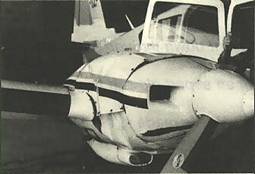
— Enroute, a low-time 172 driver decided to land to make a phone call. The airfield he picked was only semi-snow-cleared, and so he attempted a short-field landing with an 8-kt. tailwind. He didn't make it. On the roll-out the aircraft swung to the left, and right rudder didn't stop it. When the left wheel contacted snow at the edge of the runway, it dragged the aircraft around further. It slid sideways 400 ft. through deep snow, damaging the mainframe and lower cowling. Then he had a few more telephone calls to make.
— Another 172 pilot got too low on final in strong gusty winds. The mainwheels touched a snowbank just short of the threshold and the aircraft flipped onto its back (photo). He hadn't made enough allowance for the gusts and hadn't seen the snowbank.
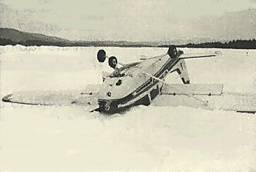
— A 150 student was practising solo for his night rating. On landing, the aircraft bounced. With the nose high, he lost track of the runway. The aircraft drifted left and, when it touched down again, the left wheel was in snow. This dragged it into a snowbank, where it nosed over inverted. Diversion of attention, even briefly, can lead to trouble.
— A Bellanca pilot was done in by a patch of slush. After the landing, the left wheel hit the patch and the machine was dragged into a snowbank and badly damaged.
— A PA28 pilot was practising "off airport procedures". The trouble was that the wind was outside the maximum crosswind limits on the runway that he elected to use. It was more favourable on other runways. He used 25° of flap on approach and landing, then brought them up shortly afler touchdown. As the aircraft decelerated, it weathercocked into the snowbank along the side of the runway. Ignoring the "book" resulted in an unexpected "off airport" landing, a bent propeller, a damaged nose gear, a crumbled wing, and probably a sadder but wiser pilot.
— The pilot of a ski-equipped 185 purposely planned to take off close to the edge of a snow-covered taxiway with center bare patches. Unfortunately, he was a little slow correcting for gyroscopic effect as he poured on the power. The aircraft swung. The left ski hit a snowbank and that was the end of the trip. The manoeuvering safety margin had been cut too fine for recovery after a mistake.
— An experienced senior commercial pilot with an instrument rating had difficulty seeing where he was going on takeoff. It had been snowing all day and the runway was covered with two inches of fresh snow. Vis was down to less than a mile. Melting snow on the heated windshield added to his visibility problem, even though he got out of the aircrafl just before takeoff to wipe it off. The runway lights were partially obscured by snow and he had trouble making out the edges of the runway. He lined up with what he thought was the center and applied takeoff power. The aircraft went straight as an arrow at a slight angle before it ran off the runway some 600 ft. along (photo). The nosegear collapsed as it plowed through a snowbank.
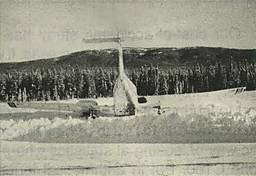
Two propellers were bent and the nose split open (photo). The provincial government operating the airport is evaluating a more suitable type of day/night/all-year runway markers.
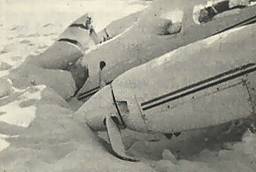
A few reminders of winter hazards from other pilots' experiences. We don't want to write about you next year.
Originally Published: ASL 1/1998
Original Article: From Issue 7/82 - Snow, Slush and Drifts




























